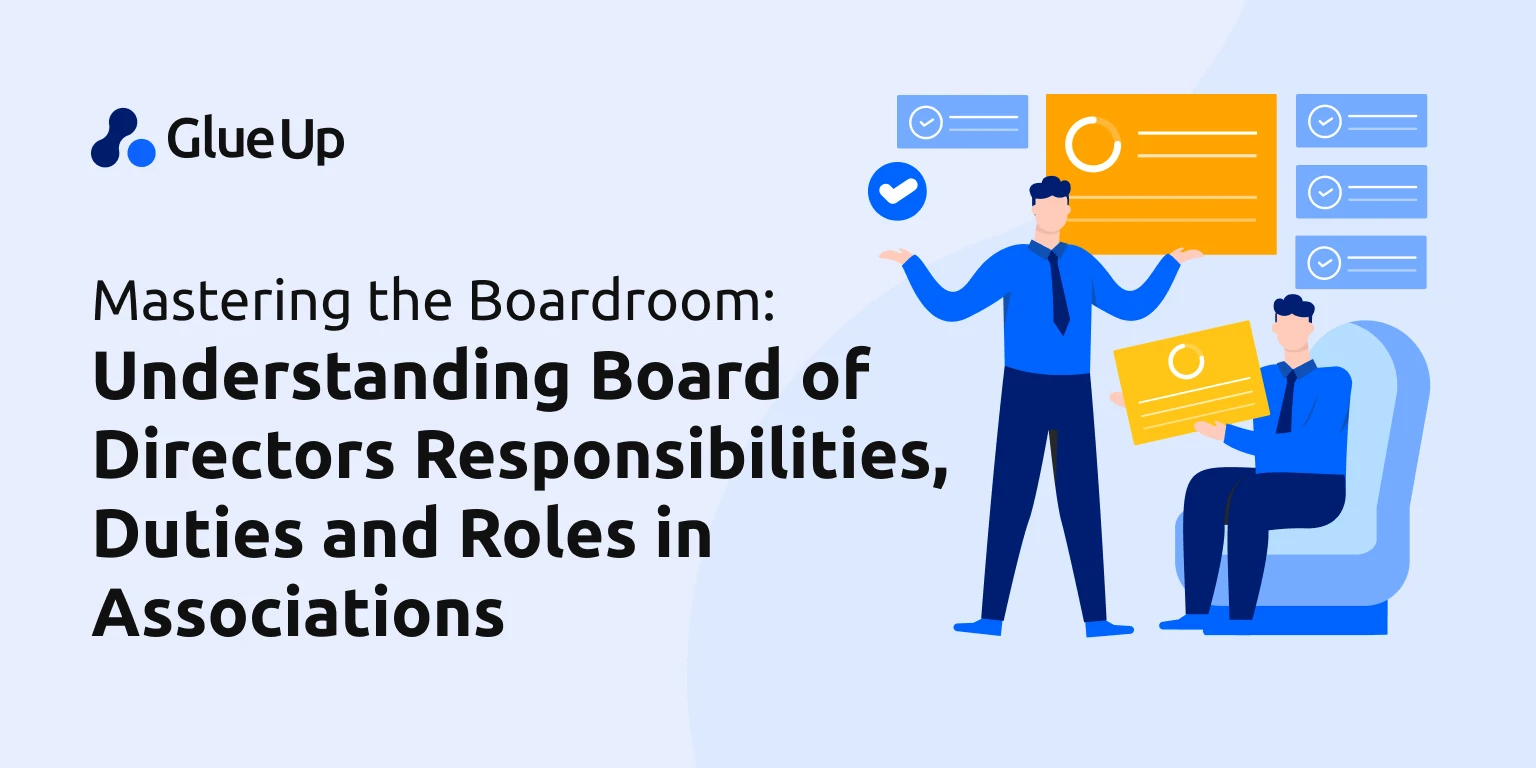
The board of directors is the cornerstone of any association, as the guiding force responsible for ensuring smooth operations.
It plays a crucial role in safeguarding stakeholders' interests and overseeing the effective functioning of every organ within the association. However, the scope of the board of directors (BOD) extends far beyond its foundational functions. In addition to its primary responsibilities, the BOD undertakes various duties and assumes distinct roles.
This blog investigates the complex details of these tasks, responsibilities, and roles of a board of directors. Continue reading to uncover a comprehensive understanding of these insights.
Key Takeaways
- The board of directors has an indispensable role in overseeing an association's operations, safeguarding stakeholder interests, and ensuring growth while outlining its diverse responsibilities and roles.
- The key duties of directors include their role as Guardians of Governance, Strategic Architects, Overseers of Performance, and Champions of Stakeholders.
- The specific roles and responsibilities of individual directors range from executive leadership and strategic direction to financial stewardship and stakeholder engagement.
- Beyond diversity and expertise, a strategic mindset, financial acumen, strong governance principles, and effective communication are essential traits for an effective board of directors.
- Glue Up AMS is a transformative tool for enhancing the board's productivity. Glue Up offers features for efficient management oversight, streamlined financial performance analysis, enhanced communication, collaboration, and strategic planning.
What Does a Board of Directors Do?

Before highlighting specifics, let's first understand the fundamental question: What does a board of directors do?
As the name suggests, this board comprises directors and other key individuals who oversee the association. Their primary responsibility is to ensure the association's operational continuity while striving to achieve growth and safeguard stakeholder interests.
The board of directors is crucial in directing the association toward its goals, including revenue and operational growth. It is dedicated to ensuring all members fulfill their duties, maintaining smooth public dealings, seizing new opportunities, and effectively managing risks.
By fulfilling these responsibilities, the board of directors contributes significantly to the overall success and sustainability of the association.
Understanding the Key Duties of the Board of Directors
Let's understand the specific Key Duties of the board of directors. Here's a breakdown of the precise roles that a board of directors undertakes:
Guardians of Governance: Ensuring Ethical and Legal Compliance
The role of this body, known as the Guardians of Governance, is instrumental in ensuring that the association meets all legal requirements and operates under the law.
In the event of any elements that may lead to a violation of these requirements, the Guardians of Governance actively investigate and make every effort to bring the association back into compliance.
A single individual does not carry out this important task; rather, multiple persons serve as Guardians of Governance, each with a distinct role:
- Association Secretaries: Often serving as guardians of governance, association secretaries play a crucial role in overseeing legal compliance, ethical conduct, and transparent governance within the organization.
- Compliance Officers: Holding the primary responsibility for implementing and monitoring compliance programs, compliance officers ensure that the association adheres to relevant laws and regulations.
- Ethics Officers: Focused on promoting ethical behavior within the organization, ethics officers play a key role in developing codes of conduct and addressing ethical dilemmas that may arise.
These individuals collectively form the Guardians of Governance, working collaboratively to safeguard the association's commitment to legal and ethical standards and rectify any possible deviations.
Strategic Architects: Charting the Course for Sustainable Success
Strategic architects are the individuals who play a crucial role in shaping the direction of an association. Their responsibilities include:
- Defining the organization's mission, vision, and core values: Strategic architects articulate the fundamental principles and purpose that guide the association's activities.
- Developing and approving strategic plans: They are instrumental in formulating plans that outline the organization's goals, objectives, and the means to achieve them.
- Making significant decisions about the organization's direction: This involves important decisions such as mergers, acquisitions, or expansion into new markets, which significantly impact the association's trajectory.
Essentially, these individuals serve as the architects of the association's strategic framework, charting a course for its success and sustained growth.
Overseers of Performance: Monitoring Management and Holding Them Accountable
The board of directors serves as the vigilant overseers of the association's performance, closely monitoring every facet of its operations, logistics, finance, and revenue.
In direct coordination with the management team, they maintain a watchful eye on the association's overall functioning. While the Board doesn't directly involve itself in conveying suggestions or initiating reforms, it establishes a direct line of communication with the management team.
This close collaboration involves regular meetings with the management team to discuss and review reports on various operational aspects. The board of directors holds the authority to conduct independent audits, ensuring a thorough assessment of the association's financial health and compliance.
Furthermore, the Board can hold the management team accountable for performance and goal achievement. The board members can offer coaching and necessary assistance to the CEO and other executives. If individuals are underperforming, the Board may facilitate replacements, including the CEO, if required.
However, maintaining a delicate balance is crucial. While the Board empowers the management team, it is equally vital for the board to maintain a certain distance. This strategic distance ensures it retains control over the association's overall trajectory without micromanaging.
This balance helps prevent situations from getting out of hand and ensures effective governance while empowering the management team and executives.
Champions of Stakeholders: Balancing Interests and Driving Long-term Value
The board of directors assumes the role of the Champions of Stakeholders, holding the responsibility to safeguard the interests of every stakeholder. This extends beyond those in positions of authority or shareholders; the Board is tasked with making decisions that benefit everyone.
The broader interests of the association incorporate stakeholders such as:
- Employees
- Customers
- Suppliers
- Investors
- The Community
In fulfilling this duty, the Board must strike a balance among these diverse interests. This involves making insightful decisions that address the needs of the hour without unduly favoring any individual group.
The Board is committed to making bold decisions, even when they might not be universally liked if they benefit the association and its stakeholders.
Achieving long-term value is a key objective for the board of directors, and this can be accomplished through various strategies, including:
Investing in Research and Development: Keeping the association innovative and adaptable to changes in the market and industry.
Building Strong Relationships with Stakeholders: Cultivating positive and mutually beneficial connections with employees, customers, suppliers, and investors.
Developing a Sustainable Business Model: Ensuring the association's operations are environmentally, socially, and economically sustainable.
Following Ethical Business Practices: Upholding high ethical standards in all business dealings and decisions.
By carefully considering the needs of diverse stakeholders, making decisions for the greater good, and investing in long-term strategies, the board of directors becomes instrumental in ensuring the association's sustained success and positive impact on the community's growth.
Navigating the Board of Directors Responsibilities: A Director's Blueprint

This section will uncover a director's blueprint, breaking down a director's specific roles and responsibilities within a board of directors.
Let's highlight the supposed duties of a director and the responsibilities they shoulder in assisting the board to make informed decisions for the association.
Executive Leadership
Leadership is at the heart of any director's role – a crucial factor determining their ability to guide an association.
However, assessing a director's leadership strategies isn't that simple; it involves considering various factors and decisions the director makes.
These considerations include:
Selecting and Compensating the CEO and Key Executives
Directors play an important role in appointing and compensating the CEO and other key executives, ensuring the association is led by competent individuals.
Providing Guidance and Oversight to Management
Directors offer valuable guidance and oversight to the management team, ensuring strategic alignment with the association's goals.
Evaluating CEO Performance and Ensuring Succession Planning
Directors are responsible for assessing the CEO's performance and actively participating in succession planning to ensure continuity in leadership.
These responsibilities collectively reflect the director's leadership expertise and ability to guide the association toward success and sustainability.
Strategic Direction
Another key responsibility of directors lies in shaping the strategies for the association. The strategic direction of an association plays a fundamental role in determining the effectiveness of directorial duties.
To ensure the association follows the right strategic path, directors focus on the following key points:
Setting the Company's Vision, Mission, and Core Values
Directors contribute to defining the association's comprehensive vision, mission, and core values, providing a guiding framework for its activities.
Approving Major Strategies and Acquisitions
Directors are vital in approving significant strategies and acquisitions, aligning these decisions with the association's extensive goals.
Assessing Risks and Opportunities
Directors actively engage in evaluating potential risks and opportunities, enabling the association to navigate challenges and capitalize on favorable circumstances.
By actively participating in these strategic aspects, directors contribute significantly to charting the course of the association, ensuring that it operates with a clear sense of purpose and direction.
Financial Stewardship
Financial management is the most significant responsibility in a director's role, as it is the cornerstone for all organizational functions.
The efficiency of finance management directly influences the association's performance, employee output, client retention, growth, and investor confidence. A competent director is distinguished by their expertise in financial stewardship.
Let's dig into the detailed breakdown of financial management and its implications:
Overseeing Financial Reporting and Internal Control
Directors are tasked with supervising the accuracy and transparency of financial reports. They ensure robust internal controls to safeguard the integrity of financial information.
Approving Budgets and Capital Expenditures
Directors play a critical role in approving budgets that align with the association's goals. They also authorize capital expenditures, contributing to strategic financial planning.
Managing Financial Risks and Ensuring Solvency
A key aspect of financial stewardship involves directors actively managing financial risks. This includes making decisions that contribute to the association's solvency and overall financial health.
By actively engaging in these financial management responsibilities, directors contribute to the overall stability and success of the association.
Stakeholder Engagement
The director is responsible for effectively engaging stakeholders and recognizing their significance in decision-making.
A responsible director ensures that decisions are made with consideration for all stakeholders, avoiding favoritism towards specific groups, such as investors or shareholders.
To achieve this impartial engagement, a director must attend to the following key points:
Representing the Interests of Shareholders and Other Stakeholders
Directors act as representatives, advocating for the interests of shareholders and other stakeholders in board discussions and decisions.
Fostering Open Communication and Transparency
Promoting a culture of open communication and transparency is crucial. Directors should facilitate the flow of information between the association and its stakeholders.
Addressing Stakeholder Concerns and Managing Reputation
A responsible director actively addresses concerns raised by stakeholders, working to maintain and enhance the organization's reputation through effective communication and problem resolution.
By attending to these points, directors contribute to a balanced and inclusive decision-making process that considers the perspectives and needs of all stakeholders.
Traits of an Effective Board: Diversity, Expertise, and Beyond

If a board of directors aims to be truly effective, it must possess a range of essential traits beyond the surface.
While diversity and expertise are critical, there's more to uncover when examining the traits of a board:
Strategic Mindset
A strategic mindset is a mode of thinking that extends beyond the ordinary, characterized by foresight, the ability to formulate long-term strategies, and the capacity to navigate challenges while devising optimal solutions for the association.
Here are the key qualities that define a strategic mindset:
Foresight: The ability to anticipate future trends, opportunities, and challenges, allowing for proactive planning and decision-making.
Long-Term Orientation: A focus on developing and implementing strategies that contribute to the association's sustained success over an extended period.
Problem-Solving Skills: A capacity to analyze complex issues, identify challenges, and formulate effective solutions that align with the organization's goals.
Innovative Thinking: The willingness to explore new ideas and approaches, fostering creativity and adaptability in response to changing circumstances.
Big-Picture Perspective: The ability to see the broader context and interconnectedness of various factors, enabling comprehensive and holistic decision-making.
These qualities collectively contribute to a robust strategic mindset, positioning individuals to navigate the complexities of the business landscape and drive the association toward long-term success.
Financial Acumen
Financial acumen is a pivotal trait that significantly contributes to the effectiveness of a board of directors. Essentially, it explains ensuring that all board members understand the organization's financial outlook comprehensively.
This involves readily utilizing available financial resources and grasping essential financial concepts.
Here, we will explore the concept of financial acumen, outlining key qualities that board members must have to make informed decisions for the association.
Evaluating Financial Performance: Effective board members should be able to scrutinize and assess the association's financial performance. This involves analyzing financial statements, income statements, and balance sheets to measure the overall health of the association.
Understanding Key Financial Ratios: Board members should understand key financial ratios well. These ratios provide insights into the organization's financial health, such as liquidity, profitability, and efficiency.
Evaluating Financial Projections and Budgets: Having a keen eye for association budgeting and financial projections is crucial for effective governance Board members should be capable of critically assessing proposed budgets and forecasts to ensure alignment with the organization's strategic objectives. This skill aids in setting realistic financial goals and monitoring progress over time.
Managing Financial Risks: Financial acumen involves understanding current financial states and anticipating and managing risks. Board members should proactively identify potential financial challenges and develop risk mitigation strategies.
Asking the Right Questions: An essential aspect of financial acumen is the ability to ask insightful and probing questions. Board members should actively engage in discussions about financial matters, seeking clarification when needed and challenging assumptions to ensure a thorough understanding of financial proposals. This practice promotes transparency and accountability within the board.
Strong Governance Principles
A crucial trait for any board of directors is the display of strong governance, which refers to leading the association with authority, making informed decisions that align with the association's best interests, and adhering to principles that ensure compliance, ethics, and legal conformity.
Strong governance goes beyond practicing organizational power; it includes a range of traits and qualities, highlighted below.
Ethical Practices
- Integrity and Honesty: Upholding a commitment to truthfulness and ethical conduct
- Fairness and Accountability: Ensuring equitable treatment and taking responsibility for decisions
- Sustainability and Corporate Social Responsibility: Incorporating environmentally sustainable practices and contributing positively to society
Compliance
- Regulatory Compliance: Adhering to laws and regulations governing the industry.
- Ethical Codes and Policies: Following a set of ethical guidelines and internal policies.
- Corporate Governance Frameworks: Implementing and sustaining effective frameworks for corporate governance.
These ethical practices and compliance measures collectively contribute to establishing robust governance.
Effective Communication
Effective communication emphasizes open and transparent interactions among board members, stakeholders, and personnel.
It involves building strong collaboration between the board and management, creating an environment that encourages the exchange of dialogues and suggestions for the continuous improvement of the association.
The primary purpose of effective communication is to establish an environment where every stakeholder feels valued, providing a platform for the expression of diverse perspectives.
Here is a breakdown of what effective communication entails:
Open and Transparent Dialogue
- Safe and Respectful Environment: Cultivating a space where individuals feel secure expressing their thoughts.
- Active Listening and Understanding: Engaging in attentive listening and comprehension to promote effective communication.
- Timely and Clear Information Sharing: Ensuring information is spread promptly and comprehensibly.
Strong Relationships with Management
- Constructive and Collaborative: Fostering a relationship between the board and management that is positive and collaborative.
- Mutual Respect and Trust: Building trust and respect between board members and the management team.
- Clear Roles and Responsibilities: Defining and communicating distinct roles and responsibilities for both parties.
Diversity of Thoughts
Diversity of thoughts extends beyond the just representation of individuals from diverse backgrounds. It involves recognizing and catering to the unique perspectives of all board members, each possessing distinct visions and mindsets.
The objective is to incorporate the viewpoints of every member, fostering a collaborative environment where a diverse array of skills contributes to the board's collective wisdom.
Within the board, members bring a range of talents: some are technically profound, others are organized, some excel in analytical skills, and others showcase proficiency in presentation and research.
Encouraging the active participation of every member, with their diverse strengths, enriches the board's discussions and results in a comprehensive pool of ideas. When embraced and utilized effectively, this diversity of thought bears fruitful results for the association, leading to innovative solutions and robust decision-making.
Beyond the Basics: Additional Insights for Aspiring Directors
After highlighting the basics of board directors, encompassing their duties, responsibilities, and essential traits, let's now shift our focus to a more detailed perspective. For aspiring directors seeking to join a board of directors, it's crucial to consider specific aspects that go beyond the fundamentals.
Exploring these finer details ensures a more informed and strategic approach to board membership.
The Path to the Boardroom: Qualifications and Experience Needed for Board Positions
For individuals aspiring to serve as directors in their respective associations, understanding the qualifications and experience required for board positions is crucial. Contrary to some misconceptions, no specific degree or diploma is mandated for becoming a director.
Instead, the key lies in possessing skills that distinguish a candidate as a valuable addition to a board.
Qualities Required
Certain essential qualities and skills should be cultivated to ascend to a directorial position. These include:
- Strong Leadership Abilities: The capacity to guide and inspire others is fundamental to effective board leadership.
- Strategic Thinking: Directors must possess the ability to think strategically, envisioning the organization's long-term goals and navigating complex challenges.
- Financial Acumen: Understanding financial matters and making sound fiscal decisions are vital competencies for directors.
- Ethical Judgment: Upholding a high standard of ethics and integrity is imperative for maintaining trust and credibility.
- Effective Collaboration and Communication: Directors must collaborate with fellow board members and communicate effectively to ensure collective decision-making.
Experience Required
When it comes to experience, there is no rigid requirement specifying a particular number of years, such as 'x' or 'y', to qualify for a board position.
However, a general guideline suggests that individuals with five to ten years of work experience, starting from a bachelor's degree, are often considered well-suited for directorial roles. Those with a doctoral degree may require less experience, although exceptions exist and are observed in various cases.
It's important to note that the required years of experience can vary significantly based on the industry, organization, and the nature of the directorial role. Different types of directors exist across a multitude of industries, each with its own set of expectations regarding experience.
In many observed cases, managerial experience, key positions, or a history of decision-making roles are often preferred for board positions. This leadership experience is a valuable asset, as it brings a practical understanding of organizational dynamics, strategic thinking, and decision-making processes.
Networking
Networking plays a pivotal role in securing a board position. Attend industry events, join professional associations, and connect with experienced board members. Building relationships within your industry opens doors and provides opportunities for consideration.
References and Recommendations
References and recommendations are critical in the board appointment process. Contact individuals who can speak to your qualifications, character, and professional accomplishments. Building a strong network of advocates will enhance your credibility and strengthen your position.
While there is no prescribed path to the boardroom, cultivating the right skills, actively networking, and preparing thoroughly can position you as a standout candidate for a directorial role.
Governance Frameworks: Understanding Different Board Structures and Models
There are different Governance Frameworks, and each association develops its unique framework tailored to its specific needs and objectives.
Let's discover the diverse Board Structures and Models organizations may adopt.
Unitary Board Structure
In this standard model, the board is a unified body responsible for strategic decision-making and day-to-day operations. It comprises executive and non-executive directors who collectively oversee the organization's affairs.
Two-Tier Board Structure
This structure segregates the governance functions into two separate tiers – a management board responsible for day-to-day operations and an independent supervisory board focused on strategic oversight and risk management.
Advisory Board Model
Organizations may opt for an advisory board that provides non-binding strategic advice to the executive team. While lacking formal decision-making powers, this model adds external expertise to inform key decisions.
Committee-Based Structure
Large organizations often implement committees within the board, such as finance, audit, and governance committees. Each committee specializes in specific areas, enhancing focused deliberation and decision-making.
Nonprofit Board Model
Nonprofit organizations typically follow a governance model where the board members guide the organization's mission, ensure financial stewardship, and oversee compliance with legal and ethical standards.
Community-Driven Boards
Some associations adopt a community-driven approach where members actively participate in decision-making processes. This model emphasizes inclusivity and collaboration in governance.
Policy Governance Model
This model focuses on setting high-level policies and delegating operational decisions to management. It ensures that the board remains strategic, concentrating on overarching objectives.
Global Governance Structures
Organizations with a global presence often have governance structures that account for diverse cultural and legal contexts. Boards may operate at different levels, coordinating to ensure consistency and compliance.
Legal and Fiduciary Duties: Knowing the Responsibilities and Potential Liabilities of Directors
The role of a director includes significant responsibilities, particularly in the context of legal and fiduciary duties.
In the following, we explain the distinct legal duties and fiduciary obligations that directors are entrusted with.
Legal and Fiduciary Duties
The director is responsible for ensuring that all members adhere to laws and regulations, encompassing:
- Corporate governance code
- Industry-specific regulations
- Financial reporting standards
Additionally, fulfilling the duty of attendance at board meetings, careful review of materials, and posing informed questions are imperative for making sound decisions beneficial to the organization.
Moreover, directors must avoid conflicts of interest, champion the association's success, and refrain from utilizing confidential information for personal gain.
Potential Liabilities
However, it is crucial to recognize potential liabilities associated with a director's responsibilities:
- Directors can be personally held liable for losses incurred by the association for not making intelligent and timely decisions
- Violations of laws or regulations may lead to fines and penalties for these directors, who can be held accountable for negligence.
- Breaches of duty have the potential to damage the director's personal and professional reputation.
Frequently Asked Questions: Your Boardroom Queries Answered

Many individuals often find themselves with questions about the boardroom. We aim to address these queries thoroughly to relieve confusion and provide clarity.
What is the Difference Between a Board of Directors and a Management Team?
The board of directors and the management team play pivotal roles in ensuring the success of an association, with each group possessing distinct responsibilities and functions. The board of directors serves as the authoritative governing body, exercising the power to formulate strategies and set the overall direction for the association.
On the other hand, the management team is entrusted with executing these strategic decisions in the day-to-day functioning of the association. They are tasked with handling routine operations, implementing the policies set by the board, and achieving operational goals.
How are Board Members Typically Compensated?
Board members typically receive compensation, but unlike hourly wages or monthly salaries, they are paid through various means, such as:
- Retainer fees
- Stock options
- Stock grants
- Other forms of compensation
What are the Potential Legal Risks for Directors?
Serving as a director is a role loaded with responsibility, accompanied by various potential risks. Some risks include:
- Breaches of Administrative Duties: Directors may face risks if they fail to fulfill their fiduciary obligations, such as acting in the organization's best interests.
- Financial and Accounting Misstatements: Inaccuracies in financial reporting or accounting practices can lead to legal and financial consequences for directors.
- Regulatory Violations: Directors must navigate and adhere to complex regulations; violations can result in legal actions and reputational damage.
- Personal Liability: Directors may be personally held responsible for decisions that lead to financial losses, legal issues, or harm to stakeholders.
Board Brilliance: Transformative Ways Glue Up Enhances Your Association's Directorial Dynamics
The role of the board of directors is undeniably crucial, and the functions it performs are very important.
Therefore, it is essential for the board to be equipped with tools that not only make its work easier but also enhance overall productivity. In this regard, Glue Up emerges as a pioneer in providing tools that facilitate the seamless operation of associations.
Let's discover what Glue Up's Association Management Software has to offer to simplify the tasks for the board of directors.
- Management Oversight: The board of directors assumes a pivotal role in monitoring the performance of the management team, ensuring effective planning, organization, execution, and evaluation of tasks. With Glue Up AMS, this oversight task becomes more efficient. The platform provides customizable dashboards, real-time insights, and advanced search functionalities for member lists, enabling the board to monitor association operations seamlessly. Roles and permissions ensure secure access control, while workflow automation streamlines processes and eliminates manual tasks.
- Financial Performance: In addressing financial responsibilities, Glue Up provides Profit and Loss reports, access to finance history, and the ability to monitor financial transactions. The platform's automatic synchronization of financial data with other systems reduces errors, offering the board an up-to-date, accurate overview for strategic decision-making.
- Communication and Collaboration: Enhancing communication and collaboration, Glue Up offers CRM with secure messaging platforms, announcement features, and real-time board member engagement analytics. Customizable reminders and task management tools help the board maintain effective communication channels, ensuring all members are informed and engaged in association activities.
- Strategic Planning and Analysis: For strategic planning and analysis, Glue Up provides roles with access to customizable dashboards, offering a visual representation of key performance indicators. The platform's reporting and analytics tools enable the board to assess association performance over time, fostering informed decision-making.
Ready to experience how Glue Up can elevate your association's management? Book a demo today to explore the full range of features and discover how it can enhance your board's productivity.



